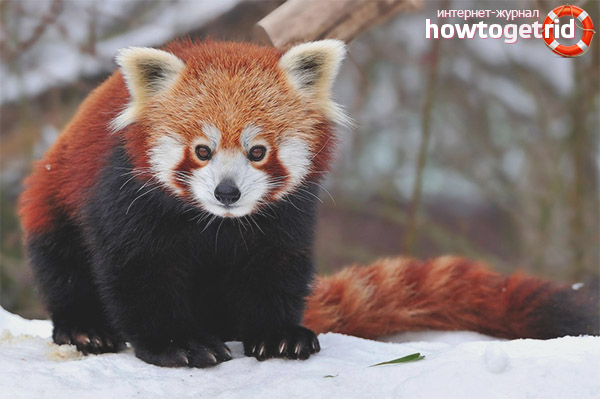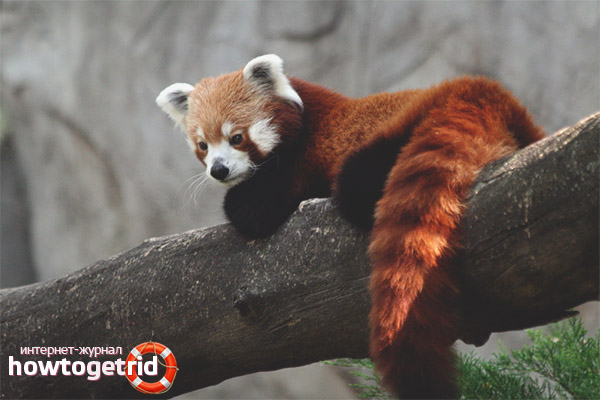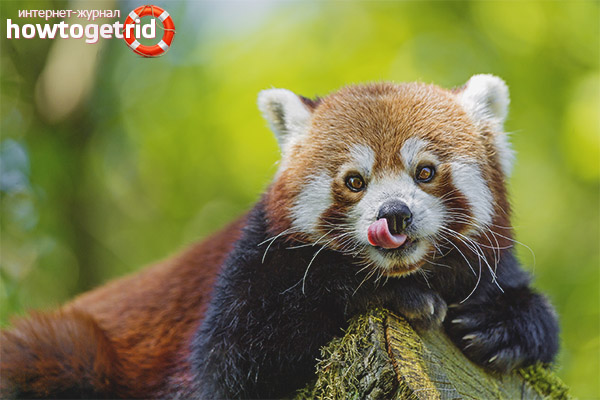The content of the article
Bright red representative of the family is almost nothing like ordinary pandas. Otherwise, it is called a red cat, according to external data there are similarities with raccoons. These agile and funny animals often become the protagonists of the video. They are distinguished by their energy, they climb trees perfectly and do not have the awkwardness that is inherent in most other pandas. In today's article, we will study everything that affects these furry creatures, get acquainted with the features in order.
Description
- In terms of their overall characteristics, these animals grow a little more than domesticated cats, they can be compared with Maine-coon. Representatives of the family grow up to 60 cm across the body. Maximum with a body weight of 5 kg. A distinctive feature is an elongated tail, which in size can grow up to half a meter. The elongated format of the body, the coat is thick, dense and upright. Because of this, the animal appears thick and larger than it actually is.
- Small pandas are distinguished by small rounded erect ears. The muzzle is blunt, sweet, lips around the edges are pigmented in black, so it seems that the animal is smiling. The eyes are dark, shiny. There are longitudinal stripes on the tail, entwining it on all sides. Individuals of feminine and masculine affiliation do not have striking differences between themselves. Unless the females have a tidier head and a smaller body itself.
- Paws shortened and dense, lump-shaped and collected brushes, strongly hairy. They are adapted for movement on slippery terrain and snow. These pandas love winter, their fur is thick and warm. Claws are bent, help animals climb trees and other heights. When walking, the brushes do not unfold completely, the panda steps on them only half.
- These predators have a bent finger located just below the wrist. It is directed in the opposite direction from the other fingers, helps to grab the roots and other parts of plants. As for the shade of the coat, it is not always red-red. Some pandochka, living in the west, can be painted brown-yellow. The red pigment is needed for those predators that camouflage among the lichens available in China.
Lifestyle
- These members of the family prefer to live apart, they do not like to gather in large groups. Some partners even diverge for the entire season, except for the mating season. However, 2-3 individuals can get along and do it well. As for the territory, at least 5 square meters per male. km land. Individuals of female gender occupy half the territory.
- The boundaries of their possessions are marked with a special secret, which is available near the anus and on the feet of the animal. Also, notes are placed by feces and urine. By smell, other representatives of the group can determine what gender, age category and fertility the owner of the site.
- These animals prefer to stay awake at dusk. In the daytime, they fall asleep, occupying free hollows or special houses built on trees. During sleep, they can cover their heads with their tail, curl up in a ball or sit and put their heads on the chest. Sleeping pandas always cause emotion.
- When it comes to the warm season, family members do not hide in the nests. They stretch down on the branches with their belly down and roll around, with their legs and tail lowered. After sleep, a mandatory washing procedure follows, since the presented individuals are fairly clean.They lick, rub, massage themselves on trees or rocks.
- An interesting feature is the fact that the tail of the animal acts as a balancing act when the pet jumps from branch to branch or crawls through trees. However, as soon as it descends to the ground, the tail loses this function. When the panda comes down from above, it does it head down. With her tail, she can wrap her arms around the trunk or monitor her balance.
- These animals love loose snow and move pretty quickly around it. They are stable on ice, run perfectly on the ground, periodically standing on their hind legs. Pandas are distinguished by their playfulness, especially when they live in groups. They can even attack a stone, and this game will be one-sided.
Life span
- Representatives of the family live in their natural habitat for about 10 years, which is almost half the duration of their captivity. The record of a long-lived panda was recorded, which turned 18 years old at the zoo.
- The presented breed group is able to control metabolism, taking care of its lifespan. They reduce or increase the norm, in this regard, becoming similar to the notorious sloths.
- When it comes to living in cold climatic regions, pandas reduce energy costs by saving their energy. Otherwise, they could not warm up. From the techniques, one can single out the feature of folding into a lump; in appearance, the animal looks like a fluffy ball of wool.
Habitat
- You can not call these medium-sized individuals very common. They mainly live in Nepal, China, northeastern India. From Nepal closer to the west, individuals of this breed group were not met. The Himalayan mountains and their southeastern part are considered to be the homeland. Predatory individuals can rise 3-4 km. up. However, the ancestors of today's pandas met at a higher altitude, evidence of this is found remains.
- If you follow the data of experts, pandas have greatly reduced their distribution area due to weather conditions. The climate is constantly changing, and they need moderate indicators with a temperature of about 15-20 degrees. Therefore, animals began to look for suitable places for themselves, leaving where they were not comfortable.
- Representatives of the family live among trees, love larch, needles. They can live in a mixed strip. Pandas live in comparative dampness, where lichens and moss grow well. That is why they need a fur coat that allows them to disguise themselves.
- Despite the peaceful nature of these animals, they still have enemies in the natural environment. These include snow leopards and wolves. However, these predators are becoming less and less, accordingly, the risk of attacking pandas is reduced. The individuals discussed are trying to seek salvation on tall trees. They quickly climb up, then jump from one branch to another.
- If a predator finds a panda on the ground, it begins to bend in an arc, showing its anger. It can periodically stand on its hind legs, after which it emits an unpleasant musky odor. It serves to scare away enemies. Eyewitnesses claimed that these pandas scream loudly. However, their voice is quiet and gentle resembling a bird.
Diet
- It is worth noting an interesting fact that about 13 hours for the considered individuals leaves the search and eating food. Pandas get their food mainly on the ground. Moreover, such animals are very strange predators. The basis of the diet includes food of plant origin.
- The presented individuals are very fond of berries, mushrooms, acorns, shoots and leaves of bamboo, lichens, succulent herbs, roots and various fruits. The real qualities of a predator in such an animal wake up closer to winter. At such a time, pandas begin an active hunt for bird eggs, rodents and insects. Thus they are stored in energy.
- Like any predator, the pandas stomach hardly digests plant fibers due to the short intestines. It is worth noting that such animals spend only a quarter of the accumulated energy. The main source of which is bamboo. Pandas carefully chew it with their 38 teeth.
- The presented individuals prefer exclusively tender and young shoots. An animal eats about 4 kg per day. such food. An additional 1.5 kg is added to this volume. green leaves. Despite the amount of feed, it is low in calories. It is interesting that in captivity such animals completely refuse any animal food.
Breeding
- As for the mating season, in the considered individuals it mainly occurs at the beginning or middle of winter. At this time, males and females behave very excitedly. They are constantly in contact. Males constantly mark territory. As for the females, they all show that they are ready for mating.
- The activity of females can be explained by the fact that estrus occurs only 1 time per year. Its duration does not exceed a day. As a result, the female walks pregnant for about 4 months. Surprisingly, the fetus begins to develop only on the 40th day. At this time, the female begins to equip the nest. She chooses a crevice in a rock or a hollow in a tree.
- Then the animal lines it with grass, leaves and branches. The birth period in such animals falls in the spring or early summer. As a result, only one cub is born, in rare cases there may be more. Young animals after birth are immediately covered with fur. They are completely defenseless and blind.
- For a while, the female constantly licks the babies in order to apply smell tags. Thus, when the mother will return home each time, she will recognize her offspring. In the first week, the mother does not leave the house and is constantly with the young. After this time, she begins to hunt and returns home only to feed the cubs.
- After 3 weeks, the babies become sighted, but they remain in the home for about 3 more months. At this age, they independently try to get out into the street at night. As soon as the pandas are six months old, they cease to eat breast milk. Offspring are strongly attached to their mother, but they do not know their father at all.
- The kinship is interrupted at the moment when the female begins to prepare again for the mating season. At this time, she is extremely irritable. At about 1 year, the young growth in size becomes the same as adult individuals. They reach puberty closer to 2 years.
View Status
- The presented individuals are listed in the Red Book and are under protection. The problem is that this species is on the verge of extinction.
- The panda population has halved over the past 20 years. Unfortunately, zoologists claim that this trend will continue for the next 3 generations.
In the world there are about 20 thousand of such individuals. Every year their number is reduced. The reason for this is man. Due to deforestation and the destruction of natural habitats, animals are dying. In addition, pandas are constantly hunted by natives.
Video: Little Panda (Ailurus fulgens)













Submit